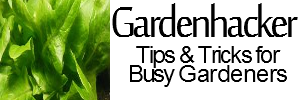The nights are getting cooler, I’m sneezing a bit with the onset of the furnace kicking in again.
One concern I’ve heard of from quite a few people is that they’re composting potentially diseased plant materials into their next years garden. I have a couple of hacks for this.
The first Quick Hack while you’re trying to figure out what to do with the refuse from the vegetable garden: If it’s not diseased, make a special compost heap just for the flower garden and put it there. You don’t have to be a composting expert, just pile up the brown, pile on the green (lawn clippings), run over leaves with the lawn mower to get them edible for the worms and mix it all together. Over the winter it will settle and decompose, and be ready for you in the spring. You may have to sift some of the stuff off the top, but it’ll be dark and “tasty” – to the plants at least. Using the veggie garden refuse in the flower garden allows you to use that material without endangering next year’s vegetables.
Same goes for the flower garden: if it’s not diseased, make a separate compost pile for the veggie garden and put all the refuse there. If you do have diseased plants, especially anything in the nightshade family, you’ll want to get rid of the dead plants by either burning them or discarding them in the landfill. I hate the second option – I’d rather have a burn can, burn them, or a better option would be to stuff them into a charcoal can (google “diy charcoal”), and reduce everything into something useful. That being said – I have neither a burn can or a charcoal making apparatus yet, so next year’s flower garden will be lush, and I’ll be trucking in the horse manure again, as well as planting some green manures in the next couple of days (unless I can figure out how to get my compost heap to “light up”).
The second Quick Hack that can stop this from being an issue is to dig a shallow trench, lay the stalks (or vines, or whatever) down right in their own bed, add some layers of lawn clippings and lawn-mowed leaves on top of them, cover lightly with soil and then be sure you rotate your crops!









Recent Comments